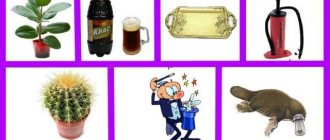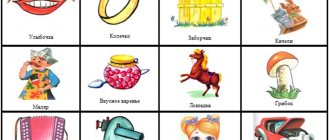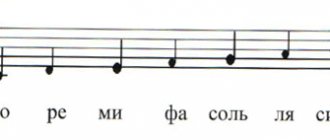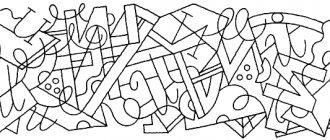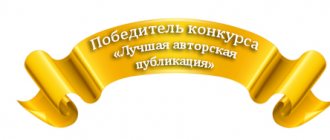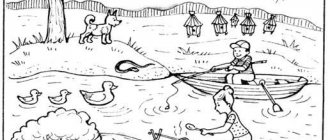Summary of speech therapy lesson “Automation of sound [R] in syllables, words”
Summary of an individual speech therapy lesson on the topic: Automation of sound [P] in syllables and words.
Target:
Automate the sound “R” in syllables, in words at the beginning and at the end of a word.
Tasks:
Educational:
— consolidation of the isolated pronunciation of the sound “R”;
— automation of the sound “R” in forward and backward syllables;
— automation of the “R” sound in words at the beginning and end of a word;
— consolidate the skill of forming nouns in the singular and plural.
Correctional and developmental:
-Development of long and smooth oral exhalation;
— Development of auditory attention and phonemic perception of the generated sound;
— Development of mental processes: visual, auditory perception and active sustained attention, memory;
-development of general, fine motor skills and touch.
Educational:
- cultivate a desire and desire to help a friend;
- interest in achieving results from the work performed.
Equipment: hero dog “Ryzhik”, “Butterfly” simulator for breathing exercises, cards for articulation exercises, mirror, “bones” cards with syllables, container for millet, millet, maze card, audio recording of words with the sound “R”, audio recording for “ Warm-up" Zheleznova, sweets.
Progress of the lesson:
1. Organizational moment.
L: Hello Denis! I'm glad to see you in our lesson. Look how many guests we have, greet them with a nod of your head.
Denis! And you know, a guest is in a hurry to join us for class. And who, I don’t know. Let us put together a picture from parts and find out who is depicted there.
(put together a picture with the image of Ryzhik)
Who is this? (dog) That's right. His name is Ryzhik. He can growl: rrrr, this is his favorite sound. And today you and I will learn to say the sound [r] beautifully and correctly in syllables and words. And Ryzhik will help us. He has prepared many different tasks for you.
Breathing exercises.
2. L: Ryzhik often plays with butterflies. He blows on them and the butterflies fly far away.
-look how I do it, and now you try to blow on a butterfly.
Articulation gymnastics.
3. L: Now you need to show Ryzhik articulation gymnastics. Choose cards and do the exercise in front of the mirror.
— “Smile, pipe” -5sec
— “Cup” - 5 sec. - “Painter” - 5 times. - “Delicious jam” - 5 times. - “Horse” - 5 times. - “Drummers” - 5-7 times.
(Ryzhik praises Denis)
4. Game “Catch the Sound”
L: Listen to how Ryzhik growls when he’s angry: RRRRRRR. Can you do this? Show me!
He wants to play the game “Catch the Sound” with you. When you hear Ryzhik growl, clap your hands.
(Distinguishing the sound “R” from other mixed sounds)
-sounds: K R D R Sh R S R L R
- syllables: RA, TA, RY, DY, RU, MU, RO, LO
-words: Chamomile, rocket, porridge, rose, paw, cook, beetle, cheese, stream.
(Ryzhik praises Denis)
5. Repetition of articulation of sound [R]: - show how Ryzhik growls.
— Tell Ryzhik about what your lips, teeth, and tongue do when pronouncing the sound [R]. (Position of the speech organs: lips are open, teeth are open, the lateral edges of the tongue are pressed against the upper molars, the wide tip of the tongue is raised to the alveoli and vibrates).
6. L: Ryzhik loves to ride in a car. He offers you a task: to help the driver of the car on the way home. The road the car is driving on is difficult. Therefore, be careful, run your finger along the path, repeating the sound “r-r-r-r-r”. Make a stop, breathe: inhale through your nose, exhale through your mouth, continue on your way, but the engine is louder and now quieter. Well done!
7. L: Ryzhik offers to give us a warm-up (Zheleznova’s disc).
8. L: What do you think we can treat Ryzhik to? (He likes to chew bones)
Exactly! I think I know where they are! Ryzhik buried them. Let's look for and treat Ryzhik. Denis, close your eyes, let them rest, and you look with your eyes closed.
Look at the syllables on the bones, read the syllables (connect them at once) and give the bones to Ryzhik.
Ra, ro, ru, ry, op, ar, ur, yr.
9. L: Now you can complete Ryzhik’s next task, go through the labyrinth. The labyrinth begins with a picture with a star. Walk with Ryzhik through the labyrinth following the arrows and name the pictures and the direction of the arrows: up, down, right or left. Remember! The sound [r] must be pronounced clearly and correctly. ( correct pronunciation
)
10. Now Ryzhik offers the game “One - Many”. Name one object and many objects. Sample: chamomile-daisies
.
11.L: Ryzhik has prepared one more task, but he can’t do it without your help. Listen to words starting with the sound “R” and name them from memory (writing down words, words starting with the letter R)
11. Summary of the lesson.
Did you like Rex's tasks? What did you like most? What will you tell your mom when you get home? Come pet Ryzhik and thank him for the activity. Ryzhik: Denis! Well done! I really enjoyed playing with you. For good work, Ryzhik gives you his favorite candies. Thank you. The lesson is over.
Abstract
individual speech therapy lesson on sound automation [P] in syllables and words.
Spent:
teacher speech therapist
Larionova T.S.
Orenburg, 2015
Progress of the lesson
Progress of an individual speech therapy lesson on sound automation [P]:
Organizing time
Good afternoon At previous classes, a red car came to us, this time it came not alone, but together with a tiger. Let's say hello to them. Today we will travel with them around Africa. First, let's go to Zanzibar, where all the residents love to do tongue exercises.
Articulation gymnastics
Each lesson on sound automation [P] begins with articulatory gymnastics:
- We smile wider, so that our teeth are visible.
(Fence - lips are open, stretched in a smile, teeth are closed).
- We will make mom happy - We will smile and kiss.
(Pipe-smile exercises alternate, each performed for 3 seconds).
- Our tongue will become a brush and quickly paint the fence.
(Let's brush the upper teeth - the mouth is slightly open, the tongue moves left and right, the lower jaw remains in a static position).
- The tongue has become a painter, Now he will paint the ceiling.
(Painter - the tip of a wide tongue should be moved back and forth across the sky).
- The cat licked the sponge and showed his tongue.
(Delicious jam - lick only the upper lip from top to bottom with a wide tongue, the mouth is open, the lower teeth do not support the tongue).
- We went for a walk in the forest together and found a mushroom there.
(Fungus - raise your wide tongue up, press it to the palate, open your mouth).
- And let's go play football, now we'll score a goal for everyone!
(Push the ball into the goal - blow cotton wool into the goal made of cubes with an air stream, stretching your lips forward. Do not puff out your cheeks).
- We click our tongues and stomp like horses.
(Horse - smile, open your mouth slightly, click your tongue on the roof of your mouth, the lower jaw should be motionless, if that doesn’t work, you can hold it with your hands).
- Like chattering turkeys, we will joke around together.
(Turkey - quickly move your tongue back and forth across your upper lip with a wide tongue, saying “bl-bl-bl”).
- Let's play a song about Antoshka on the harmonica.
(Accordion - “suck” a wide tongue to the palate, without letting go of the tongue to open and close the mouth).
- I love to drum: “D-d-d,” I tell everyone.
(Drum - open your mouth, smile, “knock” the alveoli with the tip of your wide tongue with the sound “D-d-d”).
Breathing exercises
Now we will take a swim in the Nile River.
To do this, take a glass of water from the river and a straw, and then blow to make bubbles.
Olga Bazhina
Speech therapist, project expert
Ask a Question
Development of phonemic hearing
The tiger lives in Savannah, he loves to run across the prairies and growl. His favorite sound, as you already guessed, is [R]. In addition, he really loves words with this sound. Help the tiger find and repeat them.
I will read phrases, and you name only those words that contain your favorite tiger sound.
A toothy crocodile, an Egyptian pyramid, an endless sea, Little Red Riding Hood, high mountains, a wide river, bright sun, peaceful sky, green grass, a narrow path, a long road, a fast cheetah, a long-necked giraffe, a hot day.
If necessary, explain to the child the meaning of unfamiliar words.
Automation of sound in phrasal speech
And now we have come to visit the tiger’s long-time good friend – the African elephant. This species of elephant is considered the largest in the world. He is also very smart and can even count. Let's count together with the elephant.
- One huge tiger, two huge tigers, five huge tigers;
- one pirate sail, two pirate sails, five pirate sails;
- one red gauntlet, two red gauntlets, five red gauntlets;
- one pair of roller skates, two pairs of roller skates, five pairs of roller skates.
Lesson summary
It's great to travel with new friends, but it's time to return home. We'll see the tiger, the red car and the African elephant next time.
Summary of individual lessons. Automation of the sound “R” outline of a speech therapy lesson on the topic
Summary of an individual lesson on audio automation [R]
Goal: automation of the sound [P] in syllables, words, sentences.
Tasks:
Educational:
- Practice correctly pronouncing the sound [P] in syllables, words and sentences;
- Formation of diminutive forms of nouns;
- Formation of nouns denoting names of professions;
- Know articulation exercises;
- Know the articulation of the sound P and its characteristics;
- Be able to determine the place of the sound R in words (at the beginning, in the middle, at the end);
- Know the graphic image of the letter P;
Educational:
- Develop phonemic awareness
- Develop skills in sound analysis and synthesis
- Develop holistic perception
- Development of fine and gross motor skills.
Educational:
- Fostering the desire to master correct speech;
- Cultivating positive interest in speech therapy classes
Equipment:
Cut-out picture “Bus”, cards with numbers 2 and 3, toys: a dog, an elephant, three “pedestals” (multi-colored cubes), pictures with the sound [P] at the beginning, in the middle, at the end of the word, mosaic, wall mirror, ball .
Progress of the lesson
1. Organizational moment.
- Today you and I will go to the circus. An interesting performance awaits us.
2. Articulation gymnastics.
- But before you go to the circus, you need to develop a tongue.
- Exercise “Brushing your teeth”
1.Smile
2.Show teeth, open mouth slightly
3. Using the tip of your tongue, alternately “brush” the lower and upper teeth
- Exercise "Drummer"
1.Smile
2.Open your mouth
3. Tap behind the upper teeth with the tip of your tongue, pronouncing the sound D: d-d-d (slowly at first, gradually speed up the tempo). The lower jaw is motionless. (You can try to create an artificial vibration of the tongue with a cotton swab under your tongue while frequently saying d-d-d).
- Exercise "Painter"
1.Lips in a smile
2.Open your mouth slightly
3.Stroke (“paint”) the palate with the tip of your tongue, moving your tongue back and forth
- There's a stop ahead. What can you drive to the circus? Collect the picture and you will find out what we will ride on to the circus. (The child assembles a picture “bus” from parts).
- So what will we go on?
- By bus.
- Start the engine! Go! “The motor growls R-R-R...” (The child pronounces the sound [R] loudly).
3. Characteristics of sound [P].
- What sound are we making? What is the sound [R]?
- Consonant, hard, voiced, indicated in blue, with the letter P.
4. Sound automation.
1) in syllables
- Here we are at the circus. What kind of artists do you think work in the circus? (Child's answer)
The performance begins. Trained dogs perform.
- They know the numbers: they tell them the number, and the dogs bark the same number of times.
- I will pronounce the syllable, and you repeat it, the number of times corresponding to the number:
pra - 2 doubles - 3 pairs - 2 pairs - 3
- Well done!
2) in words
— A clown is performing in the arena. It tries to show focus:
turn large objects into small ones. Shall we help him?
- Yes.
- A big bucket, and a small... bucket, box - box, cake - cake, tomato - tomato, picture - picture, pencil - pencil, shirt - shirt.
3) in sentences
- What do you think a clown does in the circus? (Child's answer) The clown makes children laugh at the circus, so he wants to make you laugh too.
- Listen to whether he speaks correctly and correct mistakes if necessary.
Ball game “It happens, it doesn’t happen”
- An ax is used to chop wood.
– Sugar is gnawing at Ira.
- The road goes along the truck.
5. Development of phonemic hearing. Formation of nouns denoting names of professions.
— During the performance, the circus orchestra plays loudly.
- Let's see what tools it has. Name the instruments whose names contain the sound [R]: drum, trumpet, piano, guitar, tambourines, accordion.
- Well done! Named the tools correctly! What do we call a person who plays the harmonica? Please answer with a complete answer. (Harmonist)
6. Dynamic pause
- If we play the harmonica, who will we be? (Imitation of playing the harmonica)
We play the harmonica
Let's clap our hands loudly!
We shake our heads slightly,
We raise our hands up!
7. Position of sound in a word.
- And the show continues at this time. A trained elephant enters the arena.
— On command, he needs to take one of the three stands. The command for him is a picture. If the sound [P] is at the beginning of the word, the elephant will stand on the first pedestal, if in the middle - on the second, and if at the end of the word - on the third pedestal. The speech therapist shows pictures (daisies, mosquito, fish, ram, fence, cow)
(The child names the picture, determines the place of the sound in the word and places the elephant on the correct stand).
8. Exercise in correctly pronouncing the sound [P].
— The show ends. The artists say goodbye to the audience.
Irk - irk - irk - everyone loves the circus.
Ry - ry - ry - balls in the hands of children
Ra - ra - ra - goodbye, kids.
Great, great, great, it’s time for the artists to rest.
(The child pronounces pure phrases after the speech therapist).
9. Fine motor skills of hands.
-When saying goodbye, the artists gave us a mosaic, let’s use mosaic tiles to lay out the letter R.
10. Summary of the lesson.
- It's time to go home.
— Polina, tell me, which artists’ performances did you like? Please answer with a complete answer.
— What sound did we take with us to the circus? (Child's answer).

